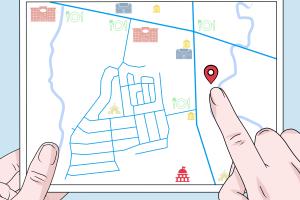Unlocking Addresses: How to Use Latitude & Longitude Coordinates Effectively

-
Quick Links:
- 1. Introduction
- 2. Understanding Latitude and Longitude
- 3. How to Use Latitude & Longitude Coordinates to Find an Address
- 4. Tools and Resources for Finding Addresses
- 5. Case Studies: Real-world Applications
- 6. Expert Insights on Geolocation Services
- 7. Step-by-Step Guide to Geocoding
- 8. FAQs
- 9. Conclusion
1. Introduction
In an era where GPS technology is ubiquitous, knowing how to convert latitude and longitude coordinates into a physical address can be incredibly useful. From navigational apps to emergency services, the ability to accurately pinpoint locations can save time and enhance safety. This comprehensive guide will delve into how latitude and longitude work, tools available for converting these coordinates into addresses, and real-world applications of this technology.
2. Understanding Latitude and Longitude
Latitude and longitude are two coordinates used to define a point on the Earth's surface. Latitude measures how far north or south a point is from the equator, while longitude measures how far east or west a point is from the prime meridian.
2.1 What is Latitude?
Latitude is expressed in degrees, with the equator at 0° latitude. The North Pole is at 90°N, and the South Pole is at 90°S. For example, New York City is located at approximately 40.7128° N.
2.2 What is Longitude?
Longitude is also expressed in degrees, with the prime meridian at 0° longitude. Locations east of the prime meridian have positive longitude values, while those to the west have negative values. For instance, Los Angeles is situated at around 74.0060° W.
3. How to Use Latitude & Longitude Coordinates to Find an Address
Finding an address using latitude and longitude coordinates can be done through various methods. Below are some common techniques:
3.1 Using Online Mapping Services
Many online mapping services allow users to input latitude and longitude directly. Google Maps, for instance, can convert these coordinates into an address easily.
3.2 Mobile Applications
Numerous mobile applications, such as GPS navigation apps, can also convert coordinates to addresses. Apps like Waze and MapQuest provide geocoding functionalities.
3.3 Command Line Tools
For tech-savvy individuals, command line tools like curl can be employed to access APIs that convert coordinates to addresses. Examples include the Google Geocoding API.
4. Tools and Resources for Finding Addresses
Several tools and services can help in converting latitude and longitude coordinates into addresses:
- Google Maps: Simply enter the coordinates in the search bar.
- Bing Maps: Similar to Google Maps, Bing allows users to input coordinates directly.
- OpenStreetMap: A free, editable map of the world that can help in finding addresses.
- Geocoding APIs: Services like Google Geocoding API and OpenCage Geocoder provide programmatic access to convert coordinates.
5. Case Studies: Real-world Applications
Understanding how latitude and longitude coordinates are applied in real-world scenarios can provide deeper insights into their significance:
5.1 Emergency Response
Emergency services often rely on GPS coordinates to locate individuals in distress. For example, during a natural disaster, coordinates can provide quick access to affected areas.
5.2 Delivery Services
Companies like Amazon and Uber use geolocation data to optimize their delivery routes. Accurate address identification from coordinates enhances efficiency.
6. Expert Insights on Geolocation Services
Industry experts emphasize the importance of accurate geolocation data in various sectors. According to a study by Gartner, businesses that leverage geolocation services experience a 15% increase in operational efficiency.
7. Step-by-Step Guide to Geocoding
To further assist readers, here’s a detailed step-by-step guide on how to convert latitude and longitude to an address using Google Maps:
Step 1: Open Google Maps
Go to the Google Maps website or app.
Step 2: Enter Coordinates
Type the latitude and longitude values in the search box, separated by a comma.
Step 3: View the Address
After pressing enter, the map will zoom into the location, and the address will be displayed on the left panel.
8. FAQs
1. What are latitude and longitude?
Latitude and longitude are coordinates used to define a specific location on Earth.
2. How can I convert coordinates to an address?
You can use mapping services like Google Maps or APIs such as the Google Geocoding API to convert coordinates into an address.
3. Are there mobile apps for finding addresses using coordinates?
Yes, many mapping apps like Waze and Google Maps allow users to input coordinates for address retrieval.
4. Can I use coordinates without an internet connection?
While most tools require internet access, offline mapping apps may have features for coordinate-based navigation.
5. What formats do latitude and longitude come in?
Coordinates can be expressed in decimal degrees or degrees, minutes, and seconds.
6. Is it possible to get an address from a single coordinate?
Geocoding typically requires both latitude and longitude to accurately determine an address.
7. How accurate are geocoding services?
Accuracy varies between services, but many are capable of pinpointing locations within a few meters.
8. Are there free geocoding services available?
Yes, services like OpenCage and Nominatim offer free geocoding options.
9. What is reverse geocoding?
Reverse geocoding is the process of converting geographic coordinates into a human-readable address.
10. How do I find coordinates for a specific address?
Most mapping services allow users to enter an address to retrieve its latitude and longitude.
9. Conclusion
Using latitude and longitude coordinates to find an address opens up numerous possibilities for navigation, emergency response, and location-based services. With the right tools and understanding, anyone can harness this technology for personal or professional use. As GPS technology continues to evolve, the importance of accurate geolocation data will only grow.
Random Reads
- How to install hackers keyboard android
- Steam friends wishlist
- Stop discord startup
- Setup wallet iphone
- Setting up google voice
- How to adjust playback settings on youtube
- How to add yourself to google maps
- How to make video call on wechat
- How to make whitewash
- How to convert measurements easily in excel